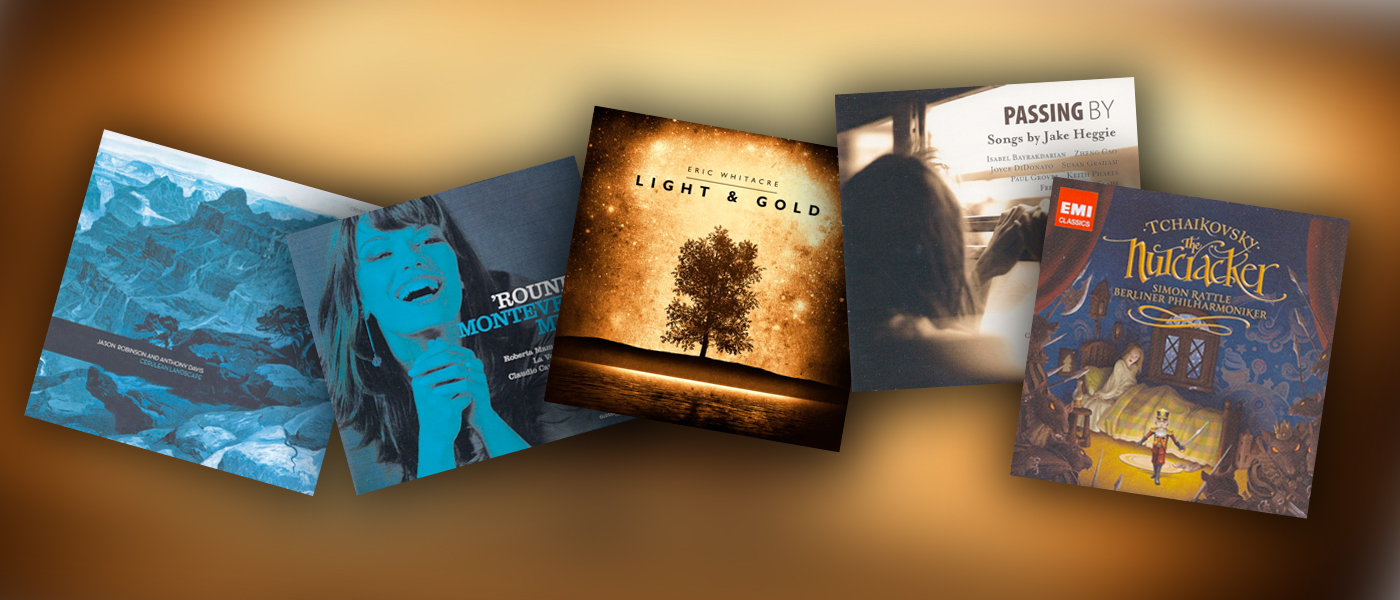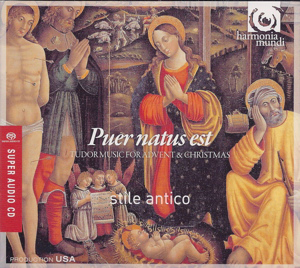
Stile Antico Puer natus est Harmonia Mundi 807517
- Performance:

- Sonics:

For its fifth release on the Harmonia Mundi label, Stile Antico brings its heavenly harmonies to Tudor music for Advent and Christmas. Beautifully recorded in DSD, and issued in high-resolution hybrid SACD format, this recording of the young English Renaissance vocal ensemble sounds wonderful on a standard CD player or laptop.
The singing is gorgeous. As lovely and sensitive as the ensemble’s tenors, baritones, and basses sound, it is the purity of its shining sopranos and warmth of its altos that uplift Stile Antico’s performances to exalted peaks. Their tone is ideal for this program, the backbone of which is Thomas Tallis’ incomplete seven-part Christmas mass, Missa Puer natus est. Three beautiful tracks from the mass are complemented by the plainchant upon which the mass is based, Puer natus est nobis.
The Tallis mass is glorious: complex in scope, adventurous in harmony, and elevated in spirit. Stile Antico clearly loves this music; they caress the vocal lines, and their soft passages are as compelling as their most forthright utterances. Thanks to producer Robina G. Young, and recording engineer Brad Michel, the resonance of All Hallows Church, Gospel Oak, London never overwhelms nor clouds the clarity and spiritual intent of the singing.
Rather than presenting the tracks of the Tallis mass sequentially, Stile Antico separates and bookeneds them with other works by Tallis, John Taverner, William Byrd, Robert White, and John Sheppard. The recording thus serves as a showcase for Renaissance England’s finest composers of sacred vocal music.
Byrd is represented by four Propers, seasonal liturgical texts set for the Votive Mass of the Blessed Virgin Mary during Advent. All come from the Gradualia of 1605, published perhaps 50 years after Tallis’ incomplete mass was first sung. Tallis’ Videte miraculum is suffused with rapt adoration and mystery. Sheppard’s Verbum caro employs a huge vocal range, and ends with his trebles dividing into three parts to sound an eight-part chord.
For contrast, compare the oldest work on the program, Taverner’s Audivi vocem de caeio, with White’s Magnificat. The former employs a narrow, four-part texture; the latter spans over three octaves spread over up to six parts, and boasts some extraordinary contrapuntal writing.
Of course, it is hardly necessary to focus on the particulars of each work. It is the overarching energy of reverence and faith that makes these works as striking as they are. This is where Stile Antico excels. Their sublime vocalism is suitable for every day and moment of the year.
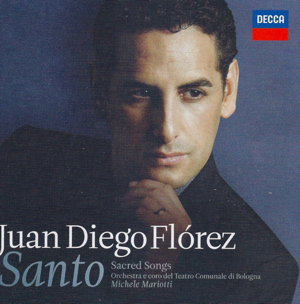
Juan Diego Flórez Santo Decca B0014875-02
- Performance:

- Sonics:

For his first recital of sacred songs, the great Rossini tenor Juan Diego Flórez joins the Orchestra & Chorus of the Teatro Comunale di Bologna under Michele Mariotti for thirteen pieces by Flux, Franck, Adam, Bellini, Handel, Rossini, Schubert, Haydn, and others (including Flórez himself). Florid singing abounds, with Flórez soaring with power and, for the most part, ease. His voice is a bit darker than in earlier years, and the tone is for the most part unvaried, but the high range remains glorious. Where Pavarotti, for example, cracked on the high C in his televised performance of the Bach-Gounod Ave Maria, Flórez sails through.
Several selections are from masses and oratorios. These include Bellini’s “Qui sedes†from the Mass in A minor, with Luca Milani beautiful on the clarinet; the familiar “Comfort ye… Every valley†from Handel’s Messiah; “Domine Deus†from Rossini’s Petite Messe solennele and “Qui tollis†and “Gratias agimus tibi†from his Messa di Gloria; Haydn’s “Mit Würd’ und Hoheit angetan†from Haydn’s Creation (Die Schöpfung); and a piece whose recording by José Carreras is ubiquitous at audio shows, “Kyrie†from Ariel Ramirez’s Misa Criolla.
Of special interest are the three works by Rossini. Conductor Mariotti, a friend of the tenor, is a natural for this music; he grew up in Pesaro, Rossini’s hometown, and studied at the town’s Conservatorio Rossini. I don’t hear any brilliant new insights in the familiar excerpt from the Petite Messe solennele, but the first high-lying excerpt from Rossini’s other mass is quite spectacular. The harder the music, the more brilliantly Flórez sings.
The Haydn excerpt is a curious one. Very different from Aksel Schiøtz’s famous recording, it includes some surprising relaxing of energy in the first half, and a slower tempo replacing feminine softening in the second half. As great a singer as Flórez may be in florid music, there is only so much he can do to vary his tone.
Those looking for the extra resonance and warmth that Carreras brought to Misa Criolla will find something different here. If my memory serves me correctly – why own Carreras’ CD when I seem to hear it four times a year at audiophile shows? – Flórez sings slower, and with surprising less energy in the middle of the first verse. Despite some lovely soft sweetness in the recap, and a voice in better shape than Carreras’, the older tenor remains supreme.
Strange is the word for Schubert’s “Ave Maria,†here in an arrangement by Hazell that uses different words. Similarly, “Adeste fideles†is interesting not for the performance of the melody, but for the language switch and final higher descant by Willcocks. Here, Flórez ditches any pretense to piety and climbs the ladder to heaven. I’m not complaining.
The closer is a welcome surprise: Flórez’s own “Santo.†Peruvian in inflection and spirit, it is recorded with native instruments and much flair. The music’s rhythms and verve find Flórez at his celebratory best. While the ending might have come across better had Flórez’s writing simply surged forward, the performance brings the CD to a joyous conclusion.
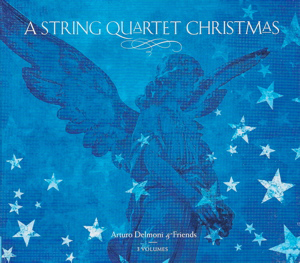
Arturo Delmoni & Friends A String Quartet Christmas Listen LSTN 50001
- Performance:

- Sonics:

Highly praised for their sound quality at the time of their initial issue, the three volumes of Arturo Delmoni and Friends’ A String Quartet Christmas were produced by John Marks. Recorded in New York City between 1995 and 1998, and issued separately by JM Records, they have been out of print for years.
Happily, the ArkivMusik website has picked them up. For one of its first CD packages on its own label, Listen (named after the website’s eponymous magazine), ArkviMusik has issued all three discs in one foldout package.
As handsome as the blue box may be, notes are minimal. Once you remove each CD and peer through the plastic holder to the paper behind it, recording information is visible. Thus we learn that Volume 1 was recorded April 24, 1995 in New York’s Church of the Holy Trinity. Produced by John Marks and mastered by Bob Ludwig, the 24 tracks of traditional carols were recorded by David Hancock using a Studer A80 analog tape recorder, running at 30 i.p.s., and Cambridge C32 ribbon microphones.
Delmoni, the constant on all three recordings, joins violinist Alexander Romanui, violist Katherine Murdock, and cellist Nathaniel Rosen on the first disc. The titles of the two-dozen Christmas carols are familiar: “Joy to the Worldâ€, “The First Noëlâ€, etc. Because most are strophic, repeating the same verse multiple timees, the quartet sensitively softens some stanzas. As lovely as the playing may be, I imagine this disc either playing in the background or used as accompaniment as folks gather around the sound system to engage in some hearty caroling.
Digital recording enters with disc 2. Recording in the Recital Hall of the Performing Arts Center at SUNY Purchase, engineer Jerry Bruck uses a NAGRA D digital tape recorder, Benchmark 20-bit A to D converter, and Schoeps KFM 6 microphones to record a mix of familiar and less familiar fare. Delmoni plays a sensitively as ever, this time supported by violinist Nina Bodnar, violist Natasha Lipkin, cellist Rosen, and, on the Bach-Gounod Ave Maria, harpist Emily Mitchell.
For Volume 3, recording engineer Bruck sticks with the NAGRA D but abandons the Benchmark for a Troisi 24-bit analog-to-digital converter and Z Systems RDP-1 24-bit digital processor. Again using Schoeps KFM 6 microphones, he gets a gratifyingly warm and inviting sound from Delmoni and Danielle Maddon on violin, Ellen DePasquale on viola, Rafael Figueroa on cello, Mitchell on harp (for seven tracks), and Timothy Smith on organ (3 tracks).
Having by this time mined much of the frequently heard repertoire, Delmoni & friends turn to three newer pieces by John Rutter, Tournier’s Six Noëls for Solo Harp, and a host of less familiar works. The verses of many of the carols may be strophic and repetitive, but the assembled forces treat each piece with such loving care that the music seems to reach out in warm embrace.
Even heard through the headphone jack on my MacBook Pro, the sound is so rich and nurturing that you just want to curl up next to your loved one and/or pet – they may be one and the same – and listen with the lights low. Lovely, lovely stuff.

American Bach Soloists What Sweeter Music ABS 885007154600
- Performance:

- Sonics:

The following reviews first appeared at sfcv.org, the website of San Francisco Classical Voices
To celebrate the season, American Bach Soloists has remastered the American Bach Choir’s lovely 2002 Christmas CD, What Sweeter Music. Available for a limited time for $7, the CD offers 15 Christmas carols from the past (English traditional) and relative present (Morten Lauridsen’s “O magnum mysterium†and John Rutter’s equally accessible “What Sweeter Musicâ€). The sweet purity of the female voices, the lovely clarity of the acoustic, and a careful selection whose tunes emphasize celebration over all else are self-recommending.
Conductor Jeffrey Thomas tempos are ideal. An example is the title track, whose beautiful flow allows us to bask in the music’s simple, sonorous beauty. It helps that the 23-person choir is in top form. Except for a little roughness near the start of the title track, the singing is exemplary.
The program was recorded in 2002 in St. Stephen’s Church, Belvedere. The recording engineers, early music specialists David Taylor and Hanneke van Proosdij, managed to find a perfect balance between up close clarity and the natural resonance of the church acoustic. They also do a fine job of capturing the sound of John Karl Hirten’s delightful, recent vintage Frobenius & Sonner organ, which enhances a few of the tracks.
To make the CD available at low cost, ABS foregoes printed liner notes. Instead, it directs purchasers to notes and texts at http://americanbach.org/recordings. While some folks may be comfortable with cozying up around the proverbial fire with the not so traditional iPhone, iPad, or computer in their lap, the truth is that very few of us read the lyrics as we listen to Christmas carols. In fact, some may find the celebratory melody of “In dulci jubilo†more uplifting when they don’t read words such as “Deeply were we stained / Per nostra crimina.†Ignorance can help foster bliss.
In addition to Lauridsen and Rutter, the CD mixes music by Britten, Vaughan Williams, Walton, Gibbs, Ord, and Drake with carols from Poland, England, Germany, and Hungary. Arrangers include David Willcocks and Zoltán Kodály. There are tons of Christmas CDs on the market, but this one’s beauty will tempt you to forego stuffing it in a stocking and instead immediately hit play.
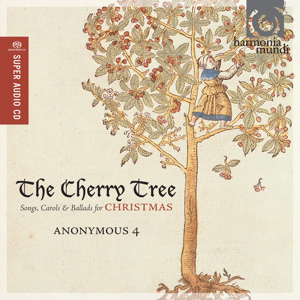
Anonymous 4 The Cherry Tree Harmonia Mundi HMU 807453
- Performance:

- Sonics:

Time has smiled sweetly on Anonymous 4. Twenty-four years after their founding, three of four members of this chart-topping a cappella women’s vocal ensemble remain, sounding as good as ever… and as simple as ever.
The approach to music and recording remains essentially unchanged. Conduct impeccable, heavily referenced scholarly research into ancient music, be it the medieval chant and polyphony of their first recording for Harmonia Mundi, An English Ladymass (1991), or the Christmas songs, carols and ballads of medieval England, Ireland, and very British-rooted early days of the Americas on their latest recording, The Cherry Tree.
Even the recording venue, Skywalker Ranch, remains unchanged. What is different, however, is the adaption of the DSD recording process, and the same hybrid SACD technology that San Francisco Symphony has used for their Mahler series. The result is a warmer, clearer, and more immediate sound, equally inviting on a two-channel CD or an SACD player rigged for two-channel playback (which, praise the good Lord, I finally have on long-term loan). I don’t have a multi-channel set-up, but given deservedly lauded producer Robina G. Young’s preference for a natural acoustic, I imagine that the multi-channel presentation is even more convincing and all enveloping. Which is all for the good.
The big criticism of Anonymous 4’s singing is that it is so pure and simple that the mind eventually drifts away from all the loveliness. There’s a reason for their style, of course. In this instance, much of their chosen repertoire received inspiration from 13th century Franciscan missionaries, who traveled to the British Isles preaching (in ensemble member Susan Hellauer’s words) “a return to a simple, selfless form of Christianity… Franciscans in Britain set in motion a wave of religious poetry and song in English, the language of the common people.â€
So there you have it. A program of predominantly 15th century English carols, songs, and ballads – Hellauer explains the difference – with two 14th century Irish “prosa†and several early American pieces thrown in. The 15th century English Cherry Tree Carol, around which the CD is organized, appears in a version collected in Kentucky in 1917, with accents appropriate. Everything is sung as the hypothetical “common people†might, with nary a trace of the gusto that our ancestors clearly reserved for cherry picking.
Will your mind drift in reverie or ennui? Only the Christmas angel knows for sure. Certainly, played in the background as you and the young innocents gather by the hearth on Christmas eve to celebrate the birth of the Christian Lord, you’ll be happy that this stocking stuffer came early. As the election season approaches, we need all the purity we can get.


